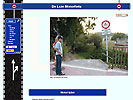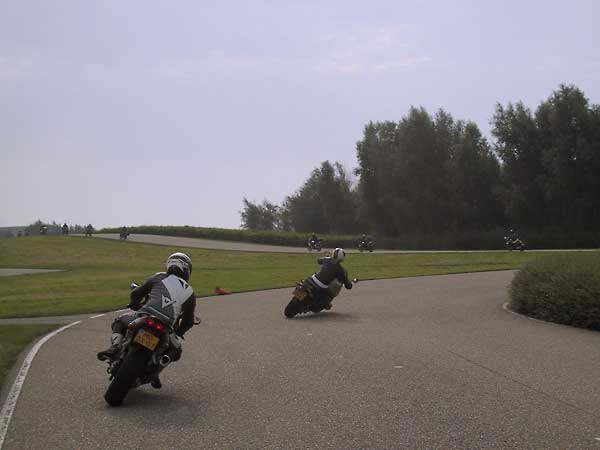
The essence of motorcycle riding is cornering: many motorcycle riders agree with that. You may keep enhancing your cornering skills for the rest of your life, and you will probably never reach full perfection (well, maybe with the exception of Valentino Rossi and Dani Pedrosa).
What kind of mistakes are often made in corners, and what is the reason for those mistakes? What can you do about it? What is the perfect line, and how do you find it? When do you brake, and what is the right speed for a corner?
Reading about cornering is, of course, not enough: you will have to practise, practise, practise.
Here some tips on how to do that
![]() Er is een Nederlandse versie:
Er is een Nederlandse versie:
https://www.luiemotorfiets.nl/tips/bochten/
So how do you ride through a corner?
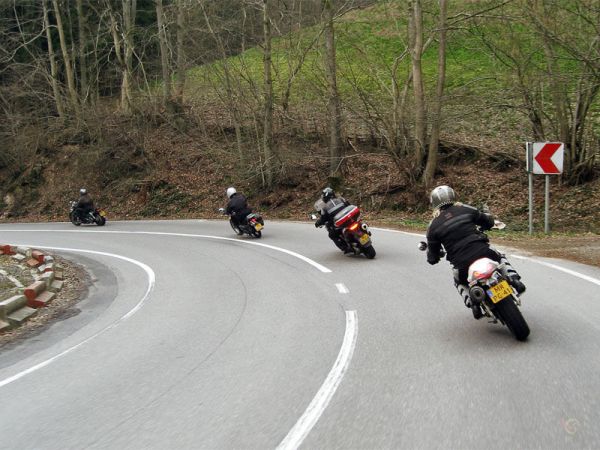
In de flow...
Sometimes, everything seems to fit together. Without being aware what you are doing, you choose the ideal line, you instinctively feel how every corner will behave, and you ride with the right speed, in the right gear, without thinking with hindsight that you could have had a higher speed, and you never get the upsetting thought that your speed is too high for the corner.
Practise conciously
Counterintuitively, you get in the flow most easily when you also try, from time to time, to be really conscious of what you do when cornering.
In cornering, everything is important: how you look through the corner in advance, how you plan your line, hou you sit on the motorcycle, how you start the corner, how you use the throttle and how you shift, how you brake in advance, and sometimes, unfortunately, how you brake or swerve in the corner itself.
Of course, reading alone will not make you better in cornering: you will have to practise, and learn to feel what happens.
But reading about cornering may help you there....
Looking
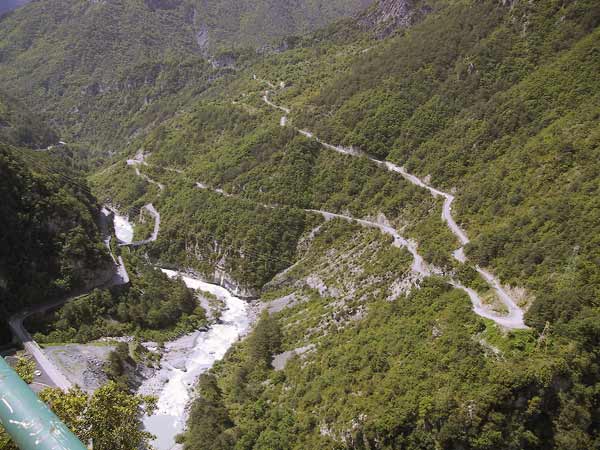
By far the most important thing to do to get your cornering fluent, is, as always with motorcycle riding, *looking*.
Judge corners
You will have to learn to judge corners, in order to be able to enter an unknown corner with the right entry speed, and in the right gear..
By looking far ahead, you can sometimes see corners long before you have arrived there, and follow the line of the road by viewing trees or lamp posts, even when you don't see the surface of the road.
Judging unknown corners gets better with experience, of course, but to accelerate that learning process, it's always good to evaluate what went wrong and why, when a certain corner surprised you somehow, or when cornering didn't feel good. Try to think whether there were signs about the corner that you missed.
Look where you want to go
In the corner itself, it's important to look where you want to go, as always (so don't look at the lonely tree, but follow the line that you want to ride, with your eyes). Always look *far ahead*.
Try to pay attention, in a corner, to the way the corner behaves: tightening curves can be very treacherous. Keep track of the "vanishing point": when it comes closer, the corner is tightening.
Looking: line through the corner

On the track
The perfect line through a corner depends on where you ride: if you are on the track, then your goal is simply to get as fast through the corner as possible. You should choose your line such that you can ride one fluent line from the point where you lean in, and such that you are able to accelerate easily throughout the corner (pull the throttle open gently). This is what the books of Keith Code will teach you.
What you can see
Outside the track, almost always your *vision* is the limiting factor. Your line then will not be the line of the optimal speed, but of the optimal vision.
Therefore, you split a corner in two:
Outside
You start the corner (lean in) where it starts, as much as possible in the outside of the corner, and you make sure that, when necessary, you have already braked and switched gears.
Before entering the corner, you should have the correct speed, be in the correct gear, and have the throttle (slightly) turned on. Then you lean in, and you stay in the outside of the corner.
Straight out
Somewhere in the corner you arrive at a point from where you, from the outside where you still are,
can ride on, in one line, to the outside of the road through the inside of the curve.
To do that, you have to lean in again, and now you accelerate out of the corner, via the inside of
the corner, to the outside.
That way, you have maximum view all the time.
Looking: tightening corners
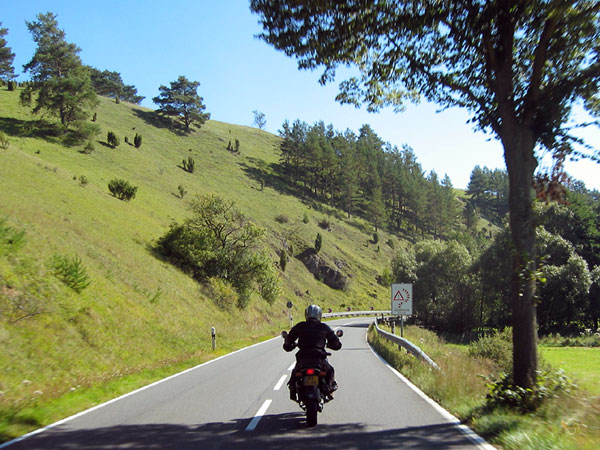
Treacherous
It is not always possible to judge corners before you enter them. A nasty kind of corner is the one with a decreasing radius. Such a corner starts easy but gets tighter.
Sometimes there are warning signs so you will not be taken by suprprise, like in this photograph, but that's not always the case.
Corners with a decreasing radius are especially treacherous because you will often not notice it until it is too late to react.
Vanishing point
You are able to notice such corners longer in advance, when you, while in the corner, keep attention to the so-called "vanishing point".
In the photograph, the vanishing point is just behind the sign. It is the point at which the inner and outer side of the corner seem to come together.
When you observe that your distance to the vanishing points keeps getting bigger, everything is alright: the corner is widening up.
But when the vanishing points gets closer, you know that the corner will get tighter. You stull have time to decrease your speed with that back brake (gently of course), or to lean in more.
Oops, didn't see it coming
OK, but what to do when you forgot to observe the vanishing point, and you are surprised, mid-corner, by a decreasing radius?
 Push your motorcycle to the inside, with your outside knee. Leaning in extra by
pushing against the inside steering handle is possible as well, but often, you have
a psychological barrier to do so in such a situation. Pushing with your knee is easier then.
Push your motorcycle to the inside, with your outside knee. Leaning in extra by
pushing against the inside steering handle is possible as well, but often, you have
a psychological barrier to do so in such a situation. Pushing with your knee is easier then.
 Use the rear brake gently. You will not only decrease your speed, but the motorcycle
will turn a bit around its rear wheel so to speak, so you will turn more into the corner.
That's exactly what you need. Mind that you don't hit the rear brake hard in panic!
Use the rear brake gently. You will not only decrease your speed, but the motorcycle
will turn a bit around its rear wheel so to speak, so you will turn more into the corner.
That's exactly what you need. Mind that you don't hit the rear brake hard in panic!
In general, you will ride corners in such a way that there still is the possibility to lean in more, on the street. After all, you only ride to the limits on a circuit.
Looking: negative camber corners
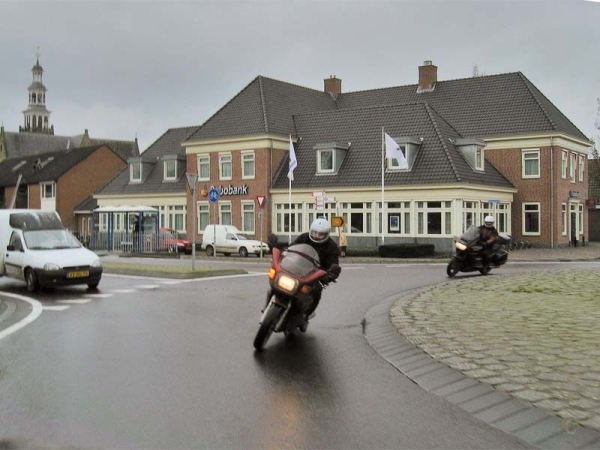
Positive camber
The ultimate form of positive camber is the wall of death. The riders in there ride very tight corners without leaning in at all.
Sometimes, you ride through corners with a positive camber, and you will notice that they are easier then they looked before you went in.
A positive camber makes you ride a curve whil your motorcycle holds a right angle to the road surface. The surface of a positive camber corner goes upwards to the outside of a corner.
Negative camber
A corner with negative camber is the opposite: the outside of the corner is lower than the inside.
That means that you have to lean in more than in the same corner and the same speed when the surface of the road would be flat, or would have a positive camber.
Often you don't see it in advance. You notice that the corner seems tighter than it looked, while it isn't the radius of the turn that is the cause.
Roundabouts
Roundabouts are often higher in the centre than at the outside, so have a negative camber.
That has been done so that dirt or oil will stream to the outside, while at the same time, traffic will be slowed down extra.
So, especially in the wet, try to keep in the inside at roundabouts (less dirt there), and be prepared that you have to lean in more than you would tell in advance, observing the corner.
Prepare: braking and changing gears

Being prepared
Before you enter a corner, you should be ready. You should have the right speed (so you should have braked enough if necessary), and you should have switched to the right gear.
The right gear is the one in which you ride through the corner easily, and which allows you to accelerate out of the corner.
Practise
A good exercise to get a feeling for which gear suits which corner, is to choose a stretch
of the road where you know each corner, and enter those corners one gear lower then you
are used to, and again, with one gear higher.
You will notice where you are in too high a gear because it is hard to accelerate without
switching to a lower gear, or when you use a too low gear because it is hard to get the
bike through the corner by gently accelerating.
Take your time
Take your time to prepare for a corner. If you have to do everything in the last moment, you will probably brake much harder, and enter the turn with a much lower speed than you would if you would prepare longer in advance.
If you really want to ride a certain distance in the shortest possible time, you would have to prepare at the last moment, of course. But even then, you are better off when you first make sure that everything else is perfect, before you start working on braking and shifting late.
If you take your time for the preparation, you can concentrate on the corner itself.
Entering the corner: Leaning in

Leaning in
In fact, the word steering is the wrong word, because it has the association of a steering wheel which you use to turn the wheels, like you do in a car, to handle a corner. That is not the way it is.
A much better word is "lean in".
You start a corner by leaning your motorcycle. You lean again in the point where you can ride out of the corner through the inside of the corner to the outside.
How?
How do you do that, lean your motorcycle in? It helps to push with your weight, and it helps to push
with your outside knee against the tank. In a corner to the left, you push the bike leftward with your
right buttock; in a corner to the right you push the bike to the right with your left buttock.
It also helps if you push against the inside handlebar. It feels like you push that handlebar downward.
(So, this is different from "steering", because you only use the handlebars to lean your motorcycle,
and use your handlebars only indirectly to get your motorcycle to ride a corner).
Countersteering
If you ever come across the word "countersteering" (you probably will): this is what it is. Some explanations sound incredibly confusing, but it's simple and clear.
When you push the motorcycle downward (or rather, when it feels as if you're pushing it downward)
through the handlebar, try to keep in mind not to automatically sit straight up and round the corner
motorcross-style.
It's better when you get used to lean with the motorcycle, or lean a little bit inwards, because you
have more ground clearance that way.
Only in very tight corners, motorcross-style can be of use, because you are more in control, so it's more easy to push the motorcycle farther or less far into the corner.
In the corner: the throttle
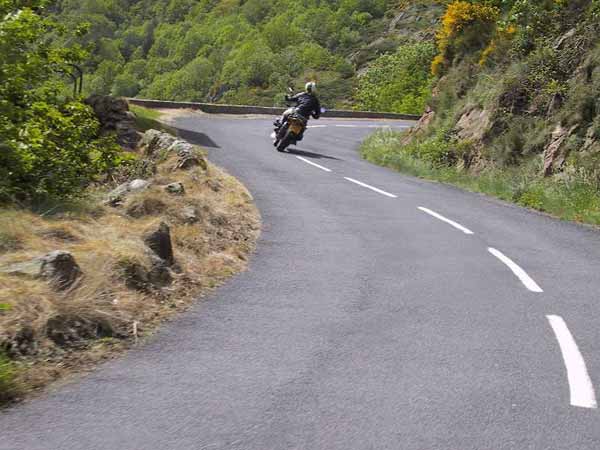
In the corner: on the throttle
The ideal situation is when you are able to turn on the throttle, little by little, during the whole corner.
Whith the throttle on, and without pulling the clutch, your motorcycle is much more stable than without the throttle or with a pulled-in clutch. When you pull the clutch during a corner, your motorcycle will "fall" to the inside.
Gently
During the first stretch of the corner, the stretch where you keep to the outside, your use of the throttle is very gently.
Out of the corner: more throttle
At the point from where you can lean in further, from where you can ride out of the corner, almost in a straight line, you can open the throttle more.
Now you can accelerate out of the corner. The acceleration will get your bike stright up again, which you need to ride in a straight line.
In the corner: Speed
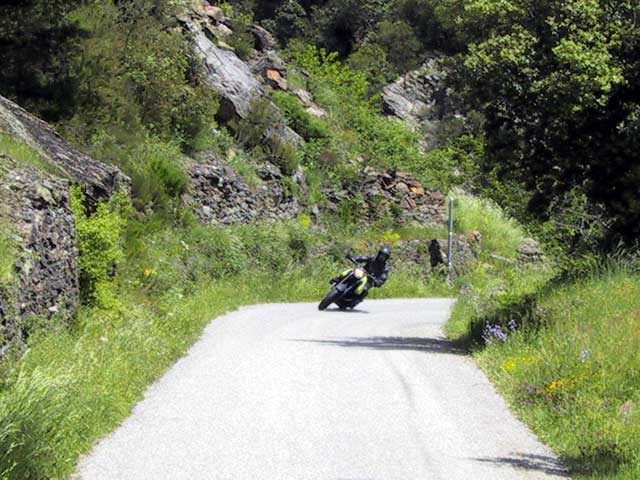
Slow in, fast out
What you should know about speed in corners is very simple: you enter them slowly and you go out fast.
Try to give your attention to the line through the corner, and to the amount of throttle you give.
Speed will come as a bonus that way.
In general, when you try to go as fast as possible, you end up going less fast than when you concentrate on what matters ;-)
The right speed
What is the right speed? There is only one correct answer: the speed at which you feel comfortable.
Not off the throttle
If you notice, halfway, that you go off the throttle, then your speed was too high (by the way, go off the throttle is not the right way to lower your speed in a corner; it is an automatic reaction that often occurs when your speed is higher than you comfort-speed).
If you notice that cornering doesn't go like you would like it to go, that you can't find the right lines, that you make mistakes like going off the throttle, than those are signs that you should enter corners at a lower speed.
Don't grab the handlebars
Other signs that you go faster than what is right for you, is when you notice that you are holding your handlebars too tightly (you always have to have a loose grip on the handlebars: your motorcycle should be able to make small steering corrections by itself), or when you are fixating one point (a tree or a lamppost).
Braking in a corner
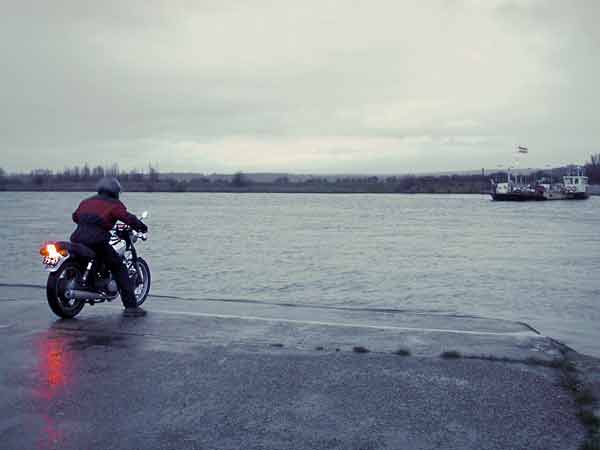
Sometimes, you have to brake
Of course, you should always try to enter a corner with the right entryspeed. But here, we suppose you didn't quite succeed and you were riding much too fast to your liking. Or you encounter a big truck in the corner, and the road is very narrow, what should you do?
In the first place, try to keep in mind that letting off the throttle is not the way to go. Somehow, that's what happens most easily, so it's difficult to get rid of that habit.
Touch the back brake
When your speed is just a little bit too fast for feeling comfortable, simply touch the back brake. Not hard of course, but just gently touch it with your foot. Your motorcycle will steer even more into the corner and will not try to straighten up, so touching the back brake is never a problem for your line, and for cornering fluently.
Emergency Brake: front and clutch
But sometimes, you really have to BRAKE. A child might cross the road, or a car pulls out from behind a hedge. In such a case, your back brake won't help you.
Pull the clutch and use the front brake
In such a case: pull the clutch, and brake with your front brake.
Be careful, and keep pushing your bike into the corner (for most people, the outer knee and outer buttock works best in this situation), because your bike will try to straighten up (and thus steer out of the corner).
When you practice, you will be able to brake rather hard in corners!
Polygon instead of a fluent line

The mistake that is made most often, in cornering, is not to ride a fluent line, but showing a polygon instead, by dividing one corner into a series of short corners. This mistake is made in different ways:
Start too early
It's possible, for instance, to start cornering too early. Then your bike ends up near the side of the road, or on the part of the road for the opposite direction, which forces you to steer out of the corner. But because you still didn't finish the corner, you will have to steer into the corner not much later, and the same process may start again.
Surprised by the corner
Another possibility is that you didn't look through the entire corner before you started it. Then you may be surprised any moment by the corner; you will have to make corrections any moment, and those steering inputs will result in a line made up of several short lines in slightly different directions.
When you observe these kind of mistakes, in yourself, it's important to decide, before you enter a corner, which line to take, and especially to look far ahead, and practise that.
Too fast

No minimum or maximum
There is no absolute speed for every corner: the right speed varies from person to person, from motorcycle to motorcycle, from tyre to tyre, and from day to day. When your name is Valentino Rossi, your maximum speed for a certain corner will probably be higher then when you have a different name, and when the weather is cold and wet, your maximum will be lower then in sunny and dry circumstances.
So, the right speed is a combination of the motorcycle (tyres, ground clearance, frame), the motorcycle rider (experience, mood, awareness), and the circumstances (the road surface, the weather, the corner).
Too fast
You entered a corner too fast if you:
 Can't resist the urge to brake during the corner,
Can't resist the urge to brake during the corner,
 Can't resist to close the throttle during the corner,
Can't resist to close the throttle during the corner,
 Don't take the corner at all, but instead ride straight on (that means that you didn't dare to
enter the corner at all).
Don't take the corner at all, but instead ride straight on (that means that you didn't dare to
enter the corner at all).
When you notice that you tend to enter corners too fast, read the piece about speed on this page, and try to concentrate on the line through the corner instead of on how fast (and related: how much leaned in) you take the corner.
In the end, you will go faster through corners than when you keep trying to keep your speed up.
Too slow?

Never a mistake!
Lots of people see it as a mistake when they notice, when having finished a corner, that they could have taken it with a higher speed. Is taking a corner "too slow" really a mistake?
When you think about it, it's only a mistake when you see it that way.
By concentrating on looking, and on the line through the corner, you will, somewhere in the future, really get that higher speed. When you enter a corner at a slower speed than might seem necessary with hindsight, it only means that you needed the slower speed, and that is no mistake at all.
The complete picture
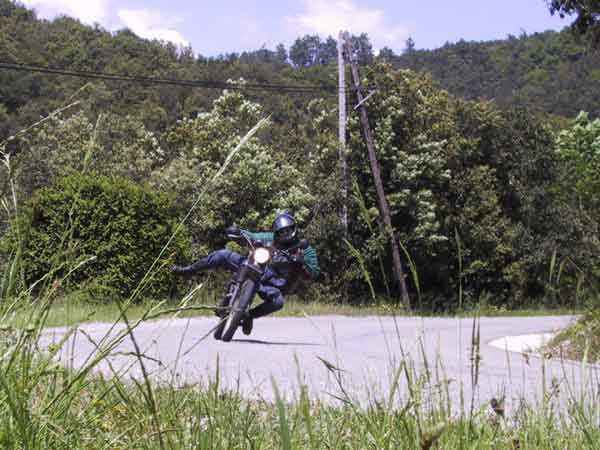
So what do you do, with all these tips and clues?
Start slowly is the rule. Do't think about what "they" will think about you.
Follow the line with your eyes
In the first place, make sure that when you enter a corner, that your eyes already have followed the line that you want to follow through the corner.
Be ready
In the second place, make sure that you are ready before the corner. So make sure that you have braked or slowed down otherwise, that you are in the right gear, and that your throttle is constant, with the speed that you want to be the entryspeed.
Lean in
Point three is entering the corner by leaning in, following your virtual line, and in the meantime keep looking far ahead, staying at the outside of the corner as long as possible.
Throttle
Point four is the throttle: you always give throttle while in a corner. You will soon be at the point where you can lean in for the second time, and you will be able to accelerate out of the corner.
From then on, you will be looking ahead for the next corner...
Enjoy!
Comments, Q & A, on a separate page




